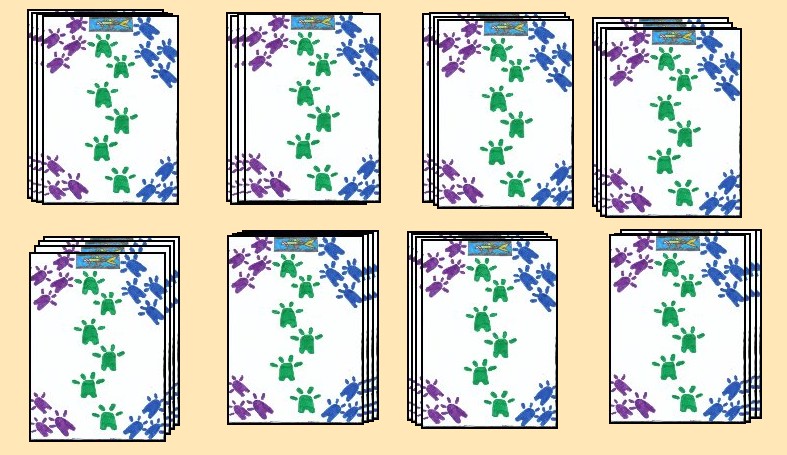Derived Shuffles
In addition to the many forms of commonly used and "natural" shuffles used at most card tables, several artificial or derived shuffling techniques have been developed.
We list them here as derived shuffles because, unlike the normal shuffles that can be done quickly and by feel, these shuffles are very methodical and deliberate. They usually involve cycling through the deck card by card, adding cards to piles or stacks. Although these shuffles are not practical for normal usage at most card tables, they are very mathematical and will mix up the deck in a specific manner.
 The Mongean Shuffle: The Mongean shuffle, also often called Monge's shuffle, consists of alternating the cards in a deck to the top and bottom of a new stack. The following steps show how to perform this shuffle:
The Mongean Shuffle: The Mongean shuffle, also often called Monge's shuffle, consists of alternating the cards in a deck to the top and bottom of a new stack. The following steps show how to perform this shuffle:
- Start by holding the entire deck face down in the left hand.
- Take the top card from the deck held in the right hand and move it to the empty right hand.
- Take the next card from the top of the deck in the left hand and place it on top of the card in the right hand.
- The next card from the top of the left hand deck would then go at the bottom of the pile held in the right hand.
- In this same manner, each card from the left hand deck would be transferred to the right hand, each card alternating between the top and the bottom of the stack in the right hand.
- This should be continued until all the cards have been moved, this alternating fashion to the right hand.
This shuffle should be repeated several times, but if performed too many times will eventually revert the deck back to its original ordering.
The steps for the Mongean shuffle described above are generally for a right handed shuffler. To perform a left handed version of the shuffle, the same steps should be followed simply reversing the hands used in each step.
The Pile Shuffle: Although not necessarily as precise and scientific as the previous shuffle, the Pile shuffle is another type of derived shuffle that can be done very mechanically. This shuffle consists of dealing the deck to a series of piles on the table. Since this shuffle can be done very carefully and with no damage to the cards, this shuffle may be done in collectible card games and with other rare or particularly valuable decks. The steps to perform the Pile Shuffle are as follows:

- Begin by holding the entire deck face down in one hand.
- Deal out one card to start each of a number of small piles. Although the number of such piles is not critical, its usually best to use between four and eight of these piles.
- Deal a second card in turn to each of the piles.
- Continue in this manner until you have completely distributed the cards to the piles.
- Starting with the first pile, reassemble the deck by stacking each pile on top of the previous one.
As with other shuffles, this shuffle can be done multiple times to increase the randomness of the final deck. Depending on the size of the original deck, the number of piles used may vary, although too few piles may serve to retain some ordering form the original deck, too many piles may decrease the localized mixing of the deck. Thus, it is found from 4 to 8 piles is usually sufficient for best results with this shuffle.
The Mexican Spiral Shuffle: The Mexican Spiral shuffle was originally devised as protection from con men and cheaters who would try to stack the deck in such a manner that would allow them to be dealt needed and winning cards. The resultant ordering of the deck after completion of this shuffle is identical to that of the Mongean shuffle, described above. The following steps describe how to perform the Mexican Spiral shuffle:
- Start with the deck held face down in one hand.
- Place the top card from the deck face down on the table.
- Place the next top card of the held stack under the stack on the table (which currently consists of just one card).
- Add the next card from the stack in the hand to the top of the deck.
- In this same way, continue removing cards from the stack in the hand, alternating between putting the top card either at the top of the stack on the table or under the stack. Continue this alternation until the entire deck has been transferred to the pile on the table.
This process should be repeated several times in order to provide a good randomization of the deck. However, if too many such shuffles are made, the deck will return to the original, pre-shuffle ordering.
Copyright © 2015
CatsAtCards.com. All rights reserved.
 The Mongean Shuffle: The Mongean shuffle, also often called Monge's shuffle, consists of alternating the cards in a deck to the top and bottom of a new stack. The following steps show how to perform this shuffle:
The Mongean Shuffle: The Mongean shuffle, also often called Monge's shuffle, consists of alternating the cards in a deck to the top and bottom of a new stack. The following steps show how to perform this shuffle:
